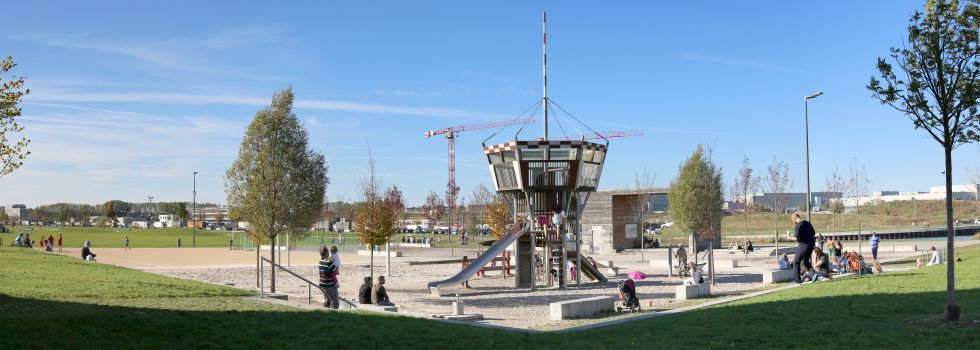Applying for the abstraction and discharge of water from surface waters
If you wish to discharge or extract water from surface waters, you require a water law licence or an elevated licence.
Responsible department
Your water authority is responsible:
for withdrawals of water from surface waters of up to 40,000 cubic metres per day and if you are not applying for the withdrawal for a business premises in accordance with § 82 Paragraph 2 Number 2 of the Baden-Württemberg Water Act (WG):
- in an urban district: the municipal administration
- in a rural district: the district administration
for abstractions of water from surface waters in excess of 40,000 cubic metres per day or those that are to take place on a company site in accordance with Section 82(2)(2) of the Baden-Württemberg Water Act (WG): the regional council (Regierungspräsidium)
Details
Prerequisite
A water law authorisation as a permit or higher-level permit is required if water from surface waters is to be used, for example for
- Irrigation / sprinkling
- Fish farming/fish ponds
- Provision of extinguishing water (e.g. extinguishing water pond)
- Dewatering
- Operational purposes (e.g. cooling, rinsing water, cleaning water)
- Other purposes (for operating a heat pump)
The authorisation granted does not give rise to any entitlement to an inflow of water in a specific quantity or quality.
No authorisation or elevated authorisation is required for the abstraction of water from surface waters
- in small quantities by scooping by means of hand containers
- in small quantities for agriculture, forestry and horticulture.
Procedure
If you wish to discharge or extract water from surface waters, you can submit an online application for a permit under water law or an elevated permit using the form provided or in writing to the competent authority.
They will review your application and decide on its authorisation. The competent authority may issue a licence under water law at its own discretion (management discretion).
The law also stipulates when a licence or higher-level licence cannot be granted.
This is the case if unavoidable, harmful changes to the water body are to be expected or other requirements under public law are not met.
Under certain circumstances, water uses of 5,000 cubic metres or more per year require an environmental impact assessment (EIA) or at least a general or site-specific preliminary assessment. Please contact the authority responsible for your application before submitting it.
Depending on the content of your application, public participation may be required by law.
Deadlines
None
Required documents
Please note that the documents you attach to the applications must be prepared and signed by authorised experts.
Below you will find a list of documents that may be required depending on the project to be applied for as well as a brief explanation.
Note: Not all of the documents listed are required for every project.
If you have any doubts as to which documents should be attached to your individual application, please contact the competent authority.
In individual cases, further documents must be submitted on request.
Explanatory report
provides a generally understandable overview of the planned project in written form and summarises the content of the other documents to be submitted; contains, in particular, information on the project sponsor, the purpose of the project, the need for and location of the project and the existing conditions (e.g. basic data on hydrology, hydraulics and soil as well as on water management and nature conservation areas), the type, scope and impact (especially environmental) of the project as well as the (existing) legal relationships under public and private law that are relevant to the project; presents alternatives to water abstraction (e.g. storage and utilisation of precipitation water) as well as alternative locations and designs, insofar as these can reduce the impact and also achieve the purpose of the measure.
Site plans
General site plan: Plan drawn up on the basis of data from an official geographical information system or sections of official topographical maps; in addition to the location of the project, the affected municipalities and districts as well as water bodies, water and spring protection areas, floodplains and nature conservation areas such as biotopes, FFH/nature conservation/landscape protection and bird protection areas must be shown; a scale adapted to the project must be selected, e.g. 1:25,000, or 1:50,000 for very large areas.
Parcel map: Plan created on the basis of data from an official geographic information system or official parcel map, if possible with contour lines; in particular, the information to be included in the general site plan and (existing) water utilisation facilities (e.g. extraction or discharge points into surface waters) must be shown. (e.g. extraction or discharge points into surface waters as well as drilling and groundwater extraction points in the form of wells or springs with names and their most important data), plots of land on which the project is to be realised with parcel numbers (if no separate parcel plan is created); a scale adapted to the project is to be selected, e.g. 1: 2,500 to 1,000.
Construction drawings
Buildings and all important components must be shown and dimensioned in floor plans and sections (not smaller than 1:100).
Water balance analysis (with a statement on the usable water supply)
If the submission of a water balance analysis is required for large abstractions, this must include a comparison of the inflow and outflow components in the area under consideration; if necessary, statements from a water balance model must be taken into account accordingly. Describe the additional load that the project will place on the water body. Check the influence on the groundwater conditions.
Information on water quality (process water, in accordance with DIN 19650)
Water from surface waters is generally not to be classified as hygienically safe. DIN 19650 "Hygienic requirements for irrigation water" from February 1999 is decisive for the irrigation of agricultural crops. According to this standard, the water is not subject to any restrictions on use if the irrigation method excludes the wetting of crops suitable for consumption (e.g. drip or root zone irrigation). If the water is to be used in a different way, the hygienic safety of the water or the suitability class must be determined using microbiological samples in accordance with Table 1 of DIN 19650. In such cases, we recommend that you contact the responsible health authority in advance.
Documentation of the extraction facility with hydraulic verification
Provides a comprehensive compilation of location, site and functional information on the planned abstraction facility, including photos of the site, measured heights, coordinates of the abstraction point, descriptions of existing abstraction facilities or structures on the watercourse. If the submission of hydraulic analyses is required, the hydraulic processes in the watercourses and in the facilities to be constructed/existing facilities caused by the project must be demonstrated. As a rule, this includes statements on the water supply as well as the discharge conditions and water levels at low, medium and high water.
Proof of prohibition of deterioration/obligation to achieve objectives
According to Section 27(1) of the German Federal Water Act (WHG), surface waters must be managed in such a way that deterioration of their ecological and chemical status is avoided and good ecological and good chemical status is maintained or achieved. Use the provisions of the Surface Waters Ordinance (OGewV) to assess and categorise the chemical and ecological status. In the case of surface waters classified as artificial or heavily modified, the ecological potential is decisive (Section 27 (2) WHG). Please contact the competent authority to find out whether a detailed "Water Framework Directive technical contribution" must be submitted.
Cadastral documents (with property register)
The land on which the project is to be carried out and on which the project will have an impact must be included in the land register, in particular the land of surface waters that are to be used; provide information on the district, parcel numbers, fishing rights and other rights of other persons (third parties), name and address of the owners, authorised users in rem and any authorised fishermen.
Specialist contribution on nature conservation (if applicable, landscape conservation plan, species protection assessment, FFH preliminary assessment or FFH impact study)
If your project is likely to have an impact on nature and the landscape, the information required to assess the impact must be provided, in particular on the location, type, extent and timing of the impact as well as the planned measures to prevent, compensate and replace the impact and information on the actual and legal availability of the areas required for compensation and replacement. An accompanying landscape conservation plan illustrates this with text and maps. To ensure compliance with species protection regulations, it must also be checked whether the project will harm protected animals or plants. A "special species conservation assessment" (saP) must be carried out for European bird species and species listed in Annex IV of the Habitats Directive. If your project affects a flora-fauna-habitat area (FFH area), the competent authority must check whether the project will have a significant impact on the area or whether a significant impact is to be expected in a preliminary assessment. You must provide the necessary documents for this. Further nature conservation documents may need to be submitted.
EIA report or application for preliminary EIA assessment (see Annex 1 No. 13 of the EIA Act)
If your planned project is subject to the obligation to carry out an environmental impact assessment (EIA), you must submit an EIA report. The content is set out in Section 16 (1) UVPG. The competent authority informs and advises the project developer on the content, scope and level of detail of the information that the project developer is expected to include in the EIA report (scope of investigation in accordance with Section 15 (1) sentence 1 EIA Act). Whether the project is subject to an EIA is determined in certain cases as part of a preliminary assessment by the authority. Please contact the competent authority.
Needs analysis
Includes a determination of the predicted demand, taking into account relevant influencing factors such as climate and ecology and, if applicable, the extraction statistics (extraction quantities) of previous years; if available, include statements from a management concept; determine and present any potential water savings.
Documents on existing abstraction facilities
Expansion plan and list of layers of the existing facility (compare planning requirements)
Other documents
Please upload here any other purpose-specific application documents that are required for the assessment of your individual project, e.g. construction descriptions and drawings, certificates of stability, proof of suitability of the systems to be operated, the system components or technical safety precautions, list of structures, data sheets as well as information on those responsible for maintenance and cost contributions.
Costs
Costs are generally incurred in the form of fees for the granting of a water licence or higher-level licence. These fees are usually based on the economic or other interest in the abstraction of water from surface waters as well as the official costs.
The legal ordinance and statutes of the respective competent authority as well as the regulations of the state fee law form the basis for the calculation of fees.
In addition to the fees for the decision , the state of Baden-Württemberg charges a water abstraction fee for the abstraction of groundwater and surface water.
The amount of the fee depends on the origin of the water (groundwater or surface water), the quantity and the use (public water supply or industrial water supply).
The basis for calculating the charge is the quantity of water actually withdrawn, which is usually recorded using appropriate measuring devices (e.g. a water meter).
Exemption from charges applies, among other things, to abstractions of up to 20,000 cubic metres per year from surface waters (excluding public water supplies) and to the abstraction of water for the purpose of irrigation or sprinkling of agricultural, horticultural and forestry land. This includes plant cultivation, including ornamental plant cultivation and tree nurseries, viticulture, horticulture and landscaping as well as forestry.
Processing time
The processing time depends on the individual case and the authorities to be involved.
Miscellaneous
none
Legal basis
Gesetz zur Ordnung des Wasserhaushalts (Wasserhaushaltsgesetz - WHG)
- § 8 Erlaubnis, Bewilligung
- § 25 Gemeingebrauch
Wassergesetz für Baden-Württemberg (WG)
- § 20 Gemeingebrauch
- § 93 Erlaubnis- und Bewilligungsverfahren
- § 100 Wasserentnahmeentgelt
- § 82 Sachliche Zuständigkeit
Gesetz über die Umweltverträglichkeitsprüfung (UVPG)
- § 4 Umweltverträglichkeitsprüfung
Umweltverwaltungsgesetz Baden-Württemberg (UVwG)
- § 10 Umweltverträglichkeitsprüfung
Release note
machine generated, based on the German release by: Umweltministerium Baden-Württemberg, 13.08.2024








